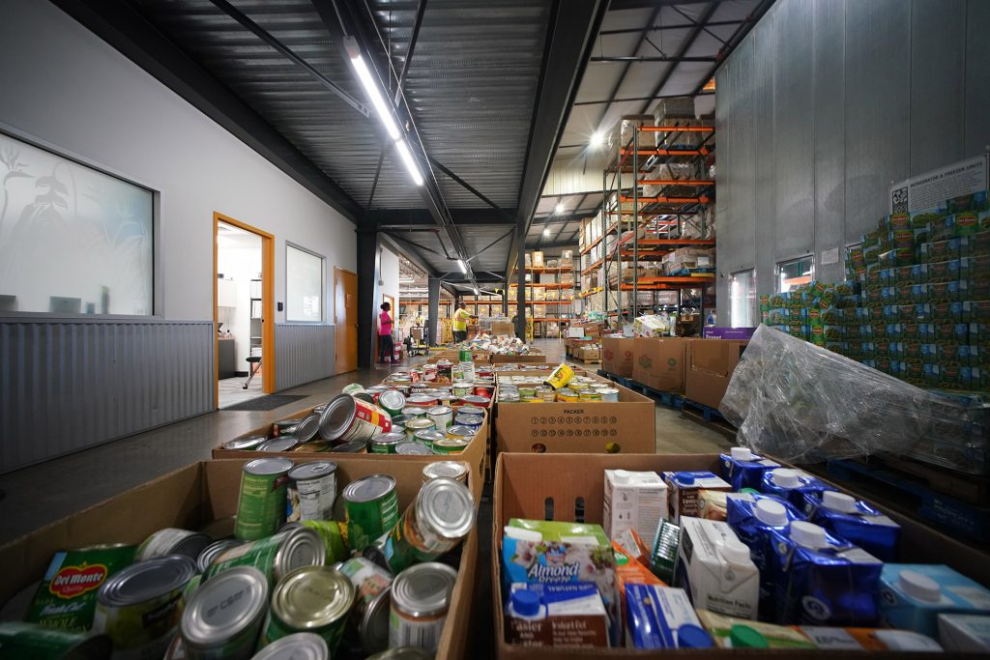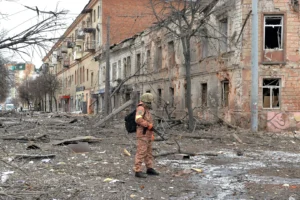The Hawaii Foodbank would need to stock up to four times more food to feed Oahu if a major disaster hit the island and spiked the number of people who already lack access to adequate food.
That estimation comes after the Aug. 8 wildfires that killed at least 99 people, destroyed more than 2,200 structures and displaced several thousand residents on Maui, increasing the demand on feeding organizations.
The problem for the Hawaii Foodbank, the state’s largest, and those serving the neighbor islands is not so much the lack of food but the lack of a place to store more of it. And that is indicative of the state’s need to better support and fund its nonprofit feeding organizations, according to the House Food, Water, and Other Supplies Working Group, one of six the chamber formed in early September to investigate Hawaii’s disaster readiness.
The working group found that Hawaii is one of few states that do not provide steady funding to its food banks, a fact that has left each of Hawaii’s major food banks without enough space to store food for a worst case scenario.
Maui Food Bank surpassed its typical annual supply of 3 million pounds of food within three months of Aug. 8, underscoring the need to expand from its two storage facilities so it can handle more than its current capacity of 250,000 pounds, according to Maui Food Bank Executive Director Richard Yust.
The Big Island also faces a short timeline for how long it would be able to serve its average of 50,000 monthly clients, according to Hawaii Food Basket Executive Director Kristin Frost Albrecht.
“It’s something we really wrestle with,” Frost Albrecht said. “If I’m being really optimistic, maybe seven days.”

Hawaii Food Bank — which operates on Oahu and Kauai — stores between 1 million and 1.5 million pounds of food at any given time, which would feed its 120,000 monthly clients for approximately three weeks, according to Executive Director Amy Miller Marvin.
“If all of a sudden everyone’s affected then our three-week reserve will only last us a couple of days,” Marvin told the House working group at its first public hearing this week.
The way that disasters such as the Aug. 8 fires or the Covid-19 pandemic have played out have illustrated that the lion’s share of the state’s residents do not follow the Hawaii Emergency Management Agency’s recommendation of keeping a 14-day supply of food and water for emergencies.
“We know food-insecure families are not able to meet that need,” said Marvin of Hawaii Food Bank.
A study earlier this year by the University of Hawaii West Oahu found that 81% of respondents did not meet the water supply recommendation, 71% did not have food stored and 61% did not have medical supplies.
Farms For Food Banks
Previous disasters have provided lessons for Hawaii’s feeding organizations, which has led many of them to look to local agriculture to keep their shelves stocked when supply chains are disrupted.
When tourism is also affected, buying local has been seen as even more valuable, because food producers lose that crucial market.

The conflagration that razed much of Lahaina is a similar situation for Maui’s food producers: A post-fire survey conducted by Hawaii Farmers Union United found 80% of farmers lost their markets and half of them lost between 75% and 100% of their customers.
Maui Food Bank made a point of paying for local produce to keep itself stocked, Yust said, which served multiple purposes.
“We realized that keeping that money on Maui pays a lot more dividends,” he said.
The idea of food relief organizations buying locally is not a new idea. It has been seen as a way to help boost local agriculture, akin to institutional spending or Da Bux food program, which doubles Supplemental Nutrition Assistance Program recipients’ spending power on local produce.
The Legislature has twice nixed legislation to foster the “Farm To Food Bank” program, which would essentially create a funding stream for food banks to buy local produce — simultaneously addressing food security and local food production.
With natural disasters in mind, creating a disaster fund dedicated to food acquisition would be useful, according to food systems and disaster planner Hunter Heaivilin.
“There’s a stranded food asset that also has a continuing and cascading economic impact on our rural households and communities that could be addressed through farm to food bank programming,” Heavilin said.
The Department of Agriculture will ask for $15 million to administer the program next year.
Next Steps
The Food, Water and Other Supplies Working Group recommended several steps to ensure greater resilience in the future, including ironing out kinks in the state’s Distribution Management Plan.

The working group found that the plan lacked a comprehensive process for community input that “can lead to inefficiencies in disaster response, potential misallocation of resources and a lack of transparency in decision-making processes.”
Hawaii Food Industry Association President and Executive Director Lauren Zirbel said that on top of increasing storage facilities for non-perishable foods, the state should pre-designate sites for mass feeding and create contractual agreements in advance with private industry to ensure readiness.
Zirbel said the state needs to improve communication by creating information hubs that help across the various areas of disaster relief, as even the food industry had trouble finding information on how to provide relief in Lahaina.
“I had to rely on personal contacts to get major companies that have food into these areas,” Zirbel said. “To me that was pretty problematic and should definitely be addressed before the next disaster happens.”
The public’s input into the working group’s process will be considered over the course of the next month and a final report will be submitted to House leadership on Dec. 15, according to co-chair Rep. Terez Amato. It may inform policymaking for the 2024 session that starts in January.
Source : CivilBeat











